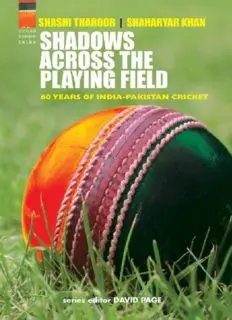
Shadows Across the Playing Field PDF
Preview Shadows Across the Playing Field
crossborder talks SHADOWS ACROSS THE PLAYING FIELD 60 YEARS OF INDIA-PAKISTAN CRICKET SHASHI THAROOR SHAHARYAR KHAN SERIES EDITOR DAVID PAGE Lotus Collection © Shashi Tharoor and Shaharyar Khan, 2009 All rights reserved. No part of this publication may be reproduced or transmitted, in any form or by any means, without the prior permission of the publisher. This edition published in June 2009 Second impression August 2009 The Lotus Collection An imprint of Roli Books Pvt. Ltd. M-75, G.K. II Market, New Delhi 110 048 Phone: ++91 (011) 40682000 Fax: ++91 (011) 2921 7185 E-mail: [email protected] Website: www.rolibooks.com Also at Bangalore, Chennai, Jaipur, Kolkata, Mumbai & Varanasi Cover Design: Supriya Saran Layout: Nabanita Das Scorecards: James Alter ISBN: 978-81-7436-718-1 Typeset in AGaramond by Roli Books Pvt. Ltd. and printed at Saurabh Printers, Okhla. OTHER CROSSBORDER TALKS TITLES: Dr Humayun Khan and G. Diplomatic Divide Parthasarathy Meghnad Desai and Aitzaz Ahsan Divided by Democracy Gyanendra Pandey and Yunas Fault Lines of Nationhood Samad Kuldip Nayar and Asif Noorani Tales of Two Cities OTHER LOTUS TITLES: Ajit Bhattarcharjea Sheikh Mohammad Abdullah: Tragic Hero of Kashmir Anil Dharker Icons: Men & Women Who Shaped Today’s India Aitzaz Ahsan The Indus Saga: The Making of Pakistan Alam Srinivas & TR Vivek IPL: The Inside Story Amir Mir The True Face of Jehadis: Inside Pakistan’s Terror Networks Ashok Mitra The Starkness of It H.L.O. Garrett The Trial of Bahadur Shah Zafar M.J. Akbar India: The Siege Within M.J. Akbar Kashmir: Behind the Vale M.J. Akbar The Shade of Swords M.J. Akbar Byline M.J. Akbar Blood Brothers: A Family Saga Maj. Gen. Ian Cardozo Param Vir: Our Heroes in Battle Maj. Gen. Ian Cardozo The Sinking of INS Khukri: What Happened in 1971 Madhu Trehan Tehelka as Metaphor Mushirul Hasan India Partitioned. 2 Vols Mushirul Hasan John Company to the Republic Mushirul Hasan Knowledge, Power and Politics Nayantara Sahgal (ed.) Before Freedom: Nehru’s Letters to His Sister Nilima Lambah A Life Across Three Continents Sharmishta Gooptu and Boria Revisiting 1857: Myth, Memory, History Majumdar (eds) Shashi Joshi The Last Durbar Shrabani Basu Spy Princess: The Life of Noor Inayat Khan Shyam Bhatia Goodbye Shahzadi: A Political Biography FORTHCOMING LOTUS TITLES: M.B. Naqvi Pakistan on Knife’s Edge Amir Mir Fluttering Flag of Jehad contents introduction david page fantasies and realities shashi tharoor rivalry and diplomacy shaharyar khan acknowledgements scorecards index The disagreements between Hindus and Muslims before 1947, and between India and Pakistan since, have thrown a long shadow across the playing fields of the world. – Ramachandra Guha, A Corner of a Foreign Field introduction i n 1987, I arrived by chance at Lahore airport at more or less the same time as Imran Khan and his teammates, who had just won their first Test series against India, followed by a 5-1 victory in the one-day internationals. Proceeding from the airport to Faletti’s hotel took a very long time as the taxi got caught up in a sea of supporters in exultant mood waving flags and cheering their heroes. I particularly remember seeing a phalanx of scooters, six or seven abreast, each with three or four young men on board, each sporting welcoming banners, on one of which was written the memorable slogan: Imran Khan Faateh-i-Hind (Conqueror of India). It was more a reception for a Mughal emperor than for a cricket team captain. The German military theorist, von Clausewitz, famously wrote that ‘war is merely the continuation of politics by other means’. For much of the last sixty years the same might also be said of the cricketing rivalry between India and Pakistan. Cricket has pride of place in the sporting calendars of both countries and no fixture is awaited with more anticipation than Tests or one-day internationals (ODIs) between them. In all cricket-playing countries, national teams carry the hopes and aspirations of millions of supporters but Indian and Pakistani teams often seem to be engaged more in a proxy war than a sporting encounter. An Indian journalist who visited both teams before their World Cup fixture in South Africa in 2003 was told by one cricketer that ‘the mood in the respective dressing rooms was akin to soldiers in a bunker, both sides desperate to emerge victorious in the end’.1 Ramachandra Guha in his classic history of cricket in India A Corner of a Foreign Field has brilliantly shown how the game has been closely entwined with politics from the very beginning.2 In nineteenth century Bombay, the Parsis and Hindus fought for their own space on the maidan in a challenge to the dominant European gymkhana which mirrored the stirrings of Indian nationalism. In the early twentieth century, the Parsi and Hindu gymkhanas were joined by a Muslim gymkhana – the Muslims taking to cricket, as they took to politics, more tardily than others – and the ground was laid for the famous
